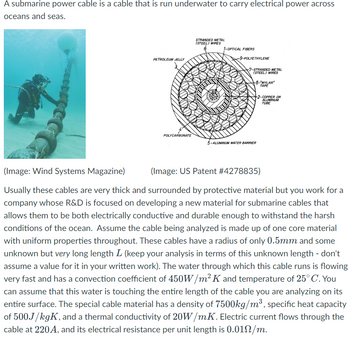
Concept explainers
a) What is the steady-state temperature of the wire surface if this current has been passing through the cable for a long period of time in these underwater conditions?
b) Assume that the cable starts at the same uniform temperature as the water and then the electrical current is passed through the cable. We're now interested in the amount of time it takes to heat up. Start by calculating the Biot number for this scenario.
c) Derive the appropriate energy balance for this transient analysis.

Trending nowThis is a popular solution!
Step by stepSolved in 3 steps with 6 images

d) Find the time constant associated with this transient analysis.
e) Find the time it takes for the temperature of the wire surface to reach a temperature that is within 2∘C of the steady-state temperature of the wire.
d) Find the time constant associated with this transient analysis.
e) Find the time it takes for the temperature of the wire surface to reach a temperature that is within 2∘C of the steady-state temperature of the wire.
- Need help on the Q.arrow_forwardIn 1 paragraph, make a narrative of what you have learned in Heat Transferarrow_forwardYou are designing a PCB laid horizontally on the ground. The PCB surface temperature can’t exceed 85℃ and has a size of 96mm x 90mm. Tinfinity = 45oC. "p" is the perimeter of the plate a) Calculate the Rayleigh number. b) If the PCB is laid hot-side UP, what is the Nusselt number and heat transfer coefficient? c) If the PCB is laid hot-side DOWN, what is the Nusselt number and heat transfer coefficient? d) Given your results from b and c, which one has better heat transfer? In that case, what is the maximum power dissipation the board can put out? Properties of Air:k = 0.025 W/mkPr = 0.72v = 1.847 x 10−5u = 16.84 x10−6p = 1.2 kg/m3B =1/ Tf (idwal gass)arrow_forward
- A pipe carries hot molten lead from one part of a factory floor to another. The mass flow rate of lead is 0.05 kg/s. While trying to figure out the heat loss from the pipe, you found that over a 2-m length of he pipe the lead temperature drops from 580 C to 557.C. What is the rate at which thermal energy is being lost from the lead carrying pipe in this 2-m section? Use the property table to find out properties of lead as needed.arrow_forwardpls ans quicklyarrow_forward
 Elements Of ElectromagneticsMechanical EngineeringISBN:9780190698614Author:Sadiku, Matthew N. O.Publisher:Oxford University Press
Elements Of ElectromagneticsMechanical EngineeringISBN:9780190698614Author:Sadiku, Matthew N. O.Publisher:Oxford University Press Mechanics of Materials (10th Edition)Mechanical EngineeringISBN:9780134319650Author:Russell C. HibbelerPublisher:PEARSON
Mechanics of Materials (10th Edition)Mechanical EngineeringISBN:9780134319650Author:Russell C. HibbelerPublisher:PEARSON Thermodynamics: An Engineering ApproachMechanical EngineeringISBN:9781259822674Author:Yunus A. Cengel Dr., Michael A. BolesPublisher:McGraw-Hill Education
Thermodynamics: An Engineering ApproachMechanical EngineeringISBN:9781259822674Author:Yunus A. Cengel Dr., Michael A. BolesPublisher:McGraw-Hill Education Control Systems EngineeringMechanical EngineeringISBN:9781118170519Author:Norman S. NisePublisher:WILEY
Control Systems EngineeringMechanical EngineeringISBN:9781118170519Author:Norman S. NisePublisher:WILEY Mechanics of Materials (MindTap Course List)Mechanical EngineeringISBN:9781337093347Author:Barry J. Goodno, James M. GerePublisher:Cengage Learning
Mechanics of Materials (MindTap Course List)Mechanical EngineeringISBN:9781337093347Author:Barry J. Goodno, James M. GerePublisher:Cengage Learning Engineering Mechanics: StaticsMechanical EngineeringISBN:9781118807330Author:James L. Meriam, L. G. Kraige, J. N. BoltonPublisher:WILEY
Engineering Mechanics: StaticsMechanical EngineeringISBN:9781118807330Author:James L. Meriam, L. G. Kraige, J. N. BoltonPublisher:WILEY





